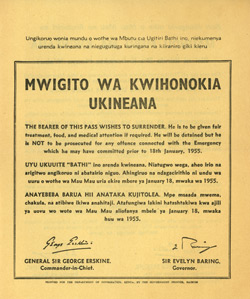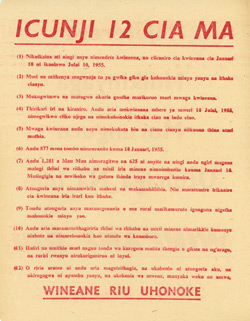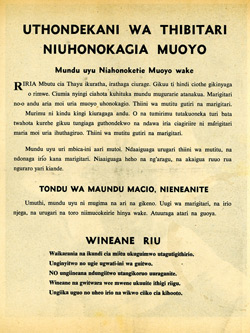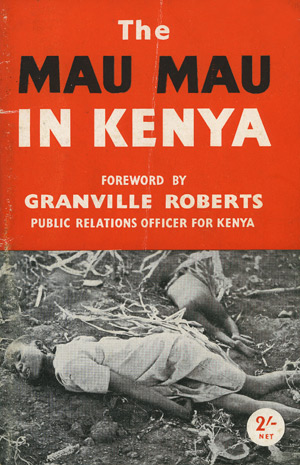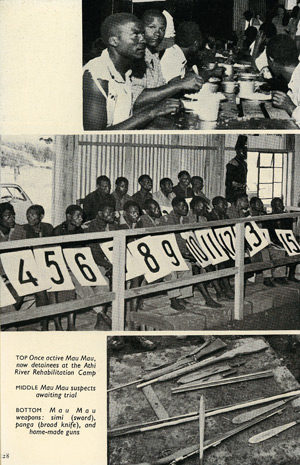Thursday, February 16, 2012
In general, British democracy has been better than others at concealing the brutal way its state functions.
Submitted by WorldRevolution
December 5, 2005
When the House of Commons was debating how much to increase the time limit for detention without trial the question of torture came up. Officially this was limited to the nice considerations of whether it was all right to send people to places where torture is used and whether Britain can use information collected by the use of torture in other countries. This discussion gave an impression of democratic Britain as the home of civilised behaviour where the very idea of torture is repugnant to our legislators – unlike, say, the US with its secret CIA jails and where Cheney has been labelled the ‘Vice President for Torture’. In reality, the British state has a long history of using and developing a whole range of torture techniques.
Interrogation in Northern Ireland
Between 1971 and ‘75 more than 2000 people were interned without trial by the state in Northern Ireland. Picked up without having any charges laid, or knowing when they were going to be released, detainees were subject to all sorts of treatments, some coming under the heading of ‘interrogation in depth’. Apart from prolonged sessions of oppressive questioning, serious threats, wrist bending, choking and beatings, there were instances of internees being forced to run naked over broken glass and being thrown, tied and hooded, out of helicopters a few feet above the ground. The ‘five techniques’ at the centre of the interrogators’ work were: sensory deprivation through being hooded (often while naked); being forced to stand against walls (sometimes for over 20 hours and even for more than 40); being subjected to continuous noise (from machinery such as generators or compressors for periods of up to 6 or 7 days); deprivation of food and water; sleep deprivation for periods of up to week. Relays of interrogation teams were used against the victims.
The British state tried to discredit reports of torture. Stories were fed to the media about injuries being self-inflicted - “one hard-line Provisional was given large whiskies and a box of king-size cigarettes for punching himself in both eyes” (Daily Telegraph, 31/10/77). There were indeed instances of self-harm, but these were either suicide attempts or done with the hope of being transferred to hospital accommodation.
Then the press said that any measures were justified if they helped to ‘prevent violence’. They contrasted “ripping out fingernails, beating people with steel rods and applying electric shocks to their genitalia” (Daily Telegraph 3/9/76), examples of “outright brutality”, with the measures used in Northern Ireland.
In 1978 the European Court of Human Rights said that the techniques Britain had used caused “intense physical and mental suffering and … acute psychiatric disturbance”, but that while this was “inhuman and degrading treatment” it didn’t amount to torture. This was a victory for the British state because it was keen to use means that would cause the maximum distress to the victim with the minimum external evidence. They had been previously referred to the European Court over torture in Cyprus, but in fact British interrogators had been using various combinations of the ‘five techniques’ for a long time. When the army and RUC approached Northern Ireland’s Prime Minister, Brian Faulkner, for formal approval “They told him that the ‘in-depth’ techniques they planned to use were those the army had used … many times before when Britain was faced with insurgencies in her colonies, including Palestine, Malaya, Kenya, Cyprus, the British Cameroons, Brunei, British Guyana, Aden, Borneo, Malaysia and the Persian Gulf” (Provos The IRA and Sinn Fein Peter Taylor).
By any means deemed necessary
British intervention in the Malayan ‘emergency’ in the 1950s has been held up as a model of suppression and ‘counter-insurgency’. Apart from the camps established, the murder squads, use of rigid food controls, burning down villages and the imposition of emergency regulations, the use of torture was an integral part of British operations. With 650,000 people uprooted and ‘resettled’ in New Villages, or put in concentration camps, there was also a programme of ‘re-education’.
British action in Kenya in the 1950s also showed what British civilisation was prepared to do. At various times over 90,000 ‘suspects’ were imprisoned, in either detention camps or ‘protected villages’. At one point Nairobi (population 110,000) was emptied, with 16,500 then detained and 2,500 expelled to reserves. Assaults and violence, often to the point of death, were extensive. As in Malaya, ‘rehabilitation’ was one of the goals of the operation. More than 1000 people were hanged, using a mobile gallows that was taken round the country. Overall, maybe 100-150,000 died through exhaustion, disease, starvation and systematic brutality.
Recent revelations in The Guardian (12/11/5) concerned a secret torture centre, the “London Cage”, that operated between July 1940 and September 1948. Three houses in Kensington were used to interrogate some 3500 German officers, soldiers and civilians. Still in use for three years after the end of the war, interrogation included beatings, being forced to stand to attention for up to 26 hours, threats of execution or unnecessary surgery, starvation, sleep deprivation, dousings with cold water etc. “In one complaint lodged at the National Archives, a 27-year-old German journalist being held at this camp said he had spent two years as a prisoner of the Gestapo. And not once, he said, did they treat him as badly as the British.”
No exceptions
There is a continuity in the British state’s actions. The Lieutenant Colonel in charge of the ‘London Cage’ received an OBE for his interrogation work in the First World War. In the 1950s there were reports of Britain experimenting with drugs, surgery and torture with a view to designing techniques that would be effective but look harmless. In the 1970s thousands of army officers and senior civil servants were trained to use psychological techniques for security purposes. Inevitably, the truth about current activities is not in the public domain.
In general, British democracy has been better than others at concealing the brutal way its state functions. Anything that is exposed is denied or dismissed as being an isolated excess. In France the extensive use of torture in the war in Algeria was publicised as part of a battle between different factions of the ruling class. Victims had hoses inserted in their mouths and their stomachs filled with water, electrodes were put on genitals, heads were immersed in water. During the Battle of Algiers 3-4000 people ‘disappeared’: fatal victims of French torture techniques.
Although France, and more recently the US in Iraq and Guantanamo Bay, have been less successful than Britain in keeping their actions under wraps, all these democracies use the most brutal methods of interrogation and detention. They also learn from each other’s activities, most notably in Vietnam, where the US drew on British experience in Malaya as much as earlier French experience in Indo-China. Any government can talk about ‘human rights’, but every capitalist state will use any means at its disposal in war or to enforce its social order.
Saturday, July 23, 2011
The sheer brutality of colonialism
09/22/2010
In my seminar on Politics and Literature of Postcolonial Africa, we have been discussing Aime Cesaire’s classic Discourse on Colonialism. For Cesahttp://www.blogger.com/img/blank.gifire (and several other radical Black intellectuals like W. E. B. DuBois), the emergence of fascism in Europe was not an anomaly, not an exceptional moment in European history.
Popular discussions, withing academia and without, encourage us to view the mass slaughter of millions of Jews under Nazi rule as an abnormality, an inexplicable deviation, in the onward march of European cultures and societies towards Progress, Reason and Enlightenment. So students are taught, very early on, to refer to “the Holocaust” in the singular, capitalizing the word to render it as a proper noun.
Cesaire argues, instead, that to view the emergence of Nazism in this light is to erase from historical memory the sheer brutality of colonial wars of conquest that have been the defining feature of European history in the modern era. In a brilliant passage (a favorite of mine), he demolishes the notion that European Nazism was an anomaly or deviation, and insists that we recognize the continuity, in cultural if not in political and economic terms, between European colonialism abroad and the Nazi atrocities at home.
I’ve been waiting a long time to quote this passage in full somewhere, and here’s my opportunity, finally. Cesaire writes:
First we must study how colonization works to decivilize the colonizer, to brutalize him in the true sense of the word, to degrade him, to awaken him to buried instincts, to covetousness, violence, race hatred, and moral relativism; and we must show that each time a head is cut off or an eye put out in Vietnam and in France they accept the fact, each time a little girl is raped and in France they accept the fact, each time a Madagascan is tortured and in France they accept the fact, civilization acquires another dead weight, a universal regression takes place, a gangrene sets in, a centre of infection begins to spread; and that at the end of all these treaties that have been violated, all these lies that have been propagated, all these punitive expeditions that have been tolerated, all these prisoners who have been tied up and “interrogated”, all these patriots who have been tortured, at the end of all the racial pride that has been encouraged, all the boastfulness that has been displayed, a poison has been distilled into the veins of Europe and, slowly but sulrey, the continent proceeds toward savagery.
And then one fine day the bourgeoisie is awakened by a terrific boomerang effect: the gestapos are busy, the prisons fill up, the torturers standing around the racks invent, refine, discuss.
People are surprised, they become indignant. They say: “How strange! But never mind – it’s Nazism, it will pass!” And they wait, and they hope; and they hide the truth from themselves, that it is barbarism, the supreme barbarism, the crowning barbarism that sums up the daily barbarisms; that it is Nazism, yes, but that before they were its victims, they were its accomplices; that they tolerated that Nazism before it was inflicted on them, that they absolved it, shut their eyes to it, legitimized it, because, until then, it had been applied only to non-European peoples; that they have cultivated that Nazism, that they are responsible for it, and that before engulfing the whole edifice of Western, Christian civilization in its reddened waters, it oozes, seeps and trickles from every crack.
The relevance of Cesaire today is not hard to understand. Think Abu Ghraib. Think Guantanamo. Think of the U.S. soldiers who have recently been accused of killing Afghan civilians “for sport.” Think of the manner in which a viciously racist campaign against Muslims and against Islam has led, in recent months, to mosques being vandalized and attacked, Muslims being physically assaulted, and Muslims as a group being blamed for the bombing of the World Trade Center.
In my seminar discussions, I often find that my students can accept all of this as true, as real, and applaud Cesaire’s polemical indictment of European imperialist culture, but balk at the political conclusions that this critique leads to. In particular, while they might learn to love Cesaire, they find the writings of Cesaire’s most famous student, Frantz Fanon, difficult to swallow, especially when they find him condoning, and indeed glorifying, violent, armed resistance to colonial rule.
One has to be reminded, time and again, of the utter savagery of imperialist domination and conquest. Absent this, it becomes difficult to comprehend the violence that resistance movements typically employ.
In this context, check out the latest blog post from ScarletGuju, a close friend and comrade of mine who is currently researching the Indian struggle for independence from British colonialism. If you ever had any doubts about the brutality of colonialism, take a look at this post, and the picture that accompanies it.
And then ask yourself what would you do if an occupying power brutalized your families, your friends, your neighbors in this manner, all for the crime of demanding the very liberty and progress that the occupiers held up as their “ideals.”
Sunday, May 15, 2011
‘Britain’s guilty secret’ of torture in Kenya to be laid bare at last
Yorkshire Post
Highly sensitive documents revealing the torture of Mau Mau Kenyans at the hands of the British authorities were a “sort of guilty secret” for the UK Government, a report has found.
Foreign Secretary William Hague said the documents, which detail how detainees were castrated, beaten and sexually abused while in British camps, should now be made public.
His announcement comes as a High Court judge is set to decide whether the UK Government, which sanctioned “systematic violence” in the detention camps, is liable for the torture of the Mau Mau people for almost a decade, between 1952 and 1961.
Last month, the High Court heard how Ndiku Mutua, Paulo Nzili, Wambugu Wa Nyingi and Jane Muthoni Mara, who are now in their 70s and 80s, were subjected to appalling abuse at the hands of the British authorities.
Mr Mutua and Mr Nzili were castrated while Mr Nyingi was beaten unconscious during an incident in which 11 men were clubbed to death. Mrs Mara was also subjected to horrendous sexual abuse during her detention.
All four want the British Government to issue a “statement of regret” and pay around £2m into a welfare fund to assist the hundreds of victims still alive.
The Government’s lawyers claim that it is the Kenyan government which is now responsible, while arguing that there has been such a delay since the atrocities occurred it can no longer be held accountable.
But the Kenyans’ legal team at Leigh Day say they have only been able to bring the case now because of recent historical research and officials at the FCO finally releasing some of the 1,500 files relating to the abuse of the Mau Mau people and their supporters.
The Government has also admitted there are some 8,800 files which were transferred to the UK when the British authorities withdrew from the colonies.
Following the revelation in January, Mr Hague requested former British High Commissioner to Canada, Anthony Cary, to conduct an internal review into what happened to the documents, known as “migrated archives”, when the British left Kenya. Mr Cary said he found there was confusion about the status of the files although some officials at the FCO realised their importance but chose to “ignore” their existence following three Freedom of Information requests from the Kenyans’ lawyers made in 2005 and 2006.
Mr Cary said: “Lack of process documentation and misunderstandings about the importance and searchability of the archives explain the failure only up to a point.
“I think it is fair to say these misapprehensions were only half believed, at least by some of the more thoughtful and knowledgeable staff (at the Foreign Office).
“It was perhaps convenient to accept the assurances of predecessors that the migrated archives were administrative and/or ephemeral, and did not need to be consulted for the purposes of FOI requests, while also being conscious of the files as a sort of guilty secret, of uncertain status and in the ‘too difficult’ tray.”
Adding that officials at the Foreign Office need urgently to review all its documents, the former British High Commissioner said: “The migrated archives saga reminds us that we cannot turn a blind eye to any of our holdings.
“All information held by the FCO should have been retained by choice rather than inertia, and must be effectively managed from a risk perspective.”
Sunday, May 08, 2011
The ugly side of Britain in the Mau Mau case
For me, the gripping court case for the week is not the appearance of six Kenyans before the International Criminal Court. The case that drew my attention is the start of the hearing of the Mau Mau case before Justice McCombe in the High Court in London.
In this case, four Kenyans have brought a representative suit in which they seek damages, compensation and a “statement of regret” from the British Government for the atrocities the British committed against Kenyans between 1952 and 1961.
The case quite unpleasantly for the David Cameron Administration brings to the fore what is now referred to as “imperialism in human rights discourse”.
In a month when the British Government has told the world that it is protecting Libyans against their government, and is at the forefront of The Hague trials for six Kenyans, that same government is refusing to compensate for the gross human rights abuses it wantonly committed against innocent and defenceless Kenyans.
The facts of the Mau Mau case are simple. The case is premised on a pattern of systematic torture, starvation, mass killing and, in some instance, burning alive of Kenyans.
The use of rape and sodomy as a form of torture and punishment was also prevalent and widespread among British soldiers.
The most common form of sexual abuse according to the pleading filed in court were “the insertion of sand into the men’s anus’’ and the insertion of glass bottles filled with hot liquid into women’s birth canals.
In one horrifying incident, 11 men were clubbed to death in the presence of the British Governor to Kenya, Sir Evelyn Baring.
To the credit of the British Government, it doesn’t deny the facts alleged by the Mau Mau claimants.
In fact, pursuant to an order by the court, the government released 300 boxes and 17,000 pages of documents that vividly describe the atrocities.
These documents were secretly shipped from Kenya a few months before independence and were thought to have been lost or destroyed.
In one of the documents, a district commissioner called C.M. “Monkey” Johnson wrote to the Attorney-General asking for amnesty to be extended because “every one of us, from the Governor downwards, may be in danger of removal from the public service”.
One will be asking that since the facts surrounding human rights abuses by the British Government are not in dispute, why is the case being contested? The answer lies in the senseless defence adopted by the British Government. It is not that the same is just laughable.
It is more a testimony to the fact that Britain has no regard for the human blood it so needlessly spilt. It is a validation of “human rights imperialism” that the West plays as its trump card.
In supporting The Hague trials of the six Kenyans and justifying the invasion of Libya, Britain is simply adhering to its deep imperialistic instinct.
It has nothing to do with human rights in the sense the rest of the world knows. In both instances, it is in line with its strategic interests in Kenya and Libya.
Robert Jay QC, the lawyer for the British Government, has applied to strike out the case on two grounds.
First, that legal liability of the British Government was transferred to Kenya in 1963 upon independence. Second, he contends that facts underpinning the case are old and the cause of action has simply “ceased to exist”. That contention is both ugly and untenable.
What is disappointing is the press coverage of this historic trial in Kenya. Both the print and electronic media have given it a wide berth.
Even the civil society, probably because their benefactor is on the dock, have kept quiet.
UK bid to cover up Mau Mau torture exposed

A mau mau veteran.
April 5 2011 at 22:00
The British Government’s efforts to cover up one of the darkest episodes in colonial history have been revealed by the discovery of a vast cache of documents relating to the bloody Mau Mau rebellion in Kenya.
The papers, documenting efforts to put down insurgency, were spirited out of Kenya on the eve of independence and have been held in secret British government archives for half a century.
The files were unearthed only this year after four elderly Kenyans sued the Foreign and Commonwealth Office, claiming they were tortured during the rebellion against British rule in Kenya between 1952 and 1960.
The claimants allege that they suffered “unspeakable acts of brutality, including castrations and severe sexual assaults”, under a system of torture carried out against the Mau Mau fighters by the British colonial authorities.
The case, which opens in the High Court in Britain on Thursday, has led to the discovery of 300 boxes of documents. The files were removed from Kenya in 1963, and secretly brought to Britain days before Kenya’s declaration of independence.
British officials deliberately removed evidence that “might embarrass Her Majesty’s Government”.
The missing material was thought to have been destroyed or lost, but after the High Court judge ordered the government to produce all relevant evidence, the documents were found in the Foreign Office archives: about 1,500 files.
The “vast majority” of the files relate to the Mau Mau, including the detention and punishment of suspected fighters, according to material released to the National Archives.
The documents appear to have been removed from Kenya as part of a policy of extracting sensitive or incriminating files from former colonies. Historians believe that similar files relating to Cyprus, Nigeria, Malaya, Palestine and other former dependent territories may also be held in secret.
“These documents were hidden away to protect the guilty,” David Anderson, Professor of African History at the University of Oxford, said on Tuesday.
“And it’s not just Kenya. What other colonial skeletons are rattling in the FCO basement? Are there secret files from Cyprus and Malaya, or from Nigeria and Rhodesia? It’s time to know the truth, however uncomfortable that may be.”
For many years, former Mau Mau detainees and their families who sought the official and legal records were told that these had been lost or destroyed, while historians have never been granted access to them.
The Kenyan claimants want a statement of regret from the government and a welfare fund for the victims. There are at least 1,400 other former Mau Mau detainees alive, and if former colonial subjects from other countries follow suit, the government could face claims for millions of pounds.
Some of those allegedly implicated are living in Britain, raising the further possibility of criminal prosecutions.
At least 12,000 fighters were killed, but atrocities were committed on both sides, and an estimated 70,000 Kenyans were held in prison camps as the British tried to quell the uprising.
The four claimants, who arrived in Britain on Tuesday, are seeking “damages for personal injuries caused by repeated assaults perpetrated by employees and agents of the British Colonial Administration in Kenya when they were detained”.
Mau Mau secret papers to be made public

BBC
May 6, 2011
The files only emerged because of a compensation claim by four Kenyans who say they were abused
A collection of sensitive documents from Britain's colonial past are to be made public through the National Archives for the first time.
The files were sent to the UK from various former territories, mostly at the time they achieved independence.
The documents emerged when four Mau Mau veterans sued the UK, saying they were tortured by Kenyan colonial government in the 1950s.
The British government says it cannot be held responsible.
It wants the claim thrown out by the High Court.
Foreign Secretary William Hague said the Foreign Office only became aware of the significance of the files in January because of research linked to the court case.
'Enormous significance'He said: "I believe that it is the right thing to do for the information in these files now to be properly examined and recorded and made available to the public.
“Start Quote
End Quote Prof David Anderson Oxford University[This] will clarify the last days of Empire in ways that will be shocking for some people in Britain”
"It is my intention to release every part of every paper of interest, subject only to legal exemptions."
Mr Hague said the job of making the papers public would be done "rapidly", but that it might take some time to complete because of the size of the archive.
David Anderson, professor of African politics at Oxford University, told the BBC the files were of "enormous significance".
He said: "These are a set of selected documents withheld for their sensitivity. We will learn things the British government of the time didn't want us to know."
"They are likely to change our view of some key places", he said. "It will clarify the last days of Empire in ways that will be shocking for some people in Britain."
RebellionThe Foreign Office says officials have briefed the governments of those former British territories which might be affected.
The four Kenyans suing the UK say they were assaulted between 1952 and 1961 by British colonial officers in detention camps during the Mau Mau rebellion.
Thousands of people involved in the rebellion, or suspected of supporting it, were sent to the camps for "screening", or interrogation.
Britain says it cannot be held responsible for the actions of a colonial government.
The Kenya Human Rights Commission has said 90,000 Kenyans were executed, tortured or maimed during the crackdown, and 160,000 were detained in appalling conditions.
Kenya a White Man's Country
"When the Missionaries arrived, the Africans had the Land and the Missionaries had the Bible. They taught us how to pray with our eyes closed. When we opened them, they had the land and we had the Bible." Jomo Kenyatta
I was unable to locate the rest of this documentary. If anyone can help, please contact me.
Assainating enemies
06/05/2011
By Amos Kareithi The powers that be have perfected methods of wishing away their nemesis. From Europe to Africa to Asia, dried bones of yesteryear dictators and liberators litter unmarked graves; their ashes are strewn all over, unremembered. When America killed global terror kingpin Osama bin Laden and secretly disposed his body at sea in an undisclosed location, tongues started wagging, but history is replete with similar incidences. Adolf Hitler achieved a rare feat by uniting Germany and triggering off a major military face off which consumed millions, and shaped the face of the world. He polarised the world, touched off a major conflict, which culminated in the use of biological warfare that claimed millions of civilians. But when the allied forces closed in on him, the leader, who had a cult like following, turned his gun on his head and left his pursuers to desecrate his remains. Lurid details are given of how the Fuehrer was first burnt and his ashes flushed down the sewerage system in Ukraine. Berlin bunker Some accounts indicate that after Hitler shot himself in his Berlin bunker, his body was burnt by his staff, along with the remains of his lover Eva Braun. Soviet troops seized the remains when they captured the bunker. But what happened later has been shrouded in mystery and speculation. Secret communications between Soviet counter-intelligence units in Germany and the Government in Moscow tell of repeated burials and exhumations of the remains, and of their final destruction by fire in 1970. Now all that remains is a four inch fragment of his skull, bearing a bullet hole exit, displayed in Moscow for public viewing, while the jaw allegedly used by Soviet investigators to identify the Nazi leader is said to be hidden in secret archives. Despite the scattering of his remains, Hilter and the organisation he founded, the Nazi, have continued to influence and inspire future generations with some secret organisations copying its mode of dress in ideology of a super human race. Nearer home in Somalia, Sayyid Muhammad Abdullah Hassan terrorised the British for 20 years until they could stomach his antics no more. Hassan, the man the British christened Mad Mullah, had set up a separate state in Dervershi, from where he continued humiliating the British. When he died on December 20, 1920 aged 64, the British authorities were keen to make his final resting place a mystery, and for fear his adherents would transform it into a shrine. Somali region His grave is believed to be somewhere close to Imay town of the Somali region of Ethiopia, but the exact spot of the tomb is not known. There have been attempts to trace and exhume his remains and rebury them at his old castle at Imme, but most people who may have known the exact place are either dead or senile. In Kenya, the British colonialists used the same script when Waiyaki wa Hinga was killed in 1902 as he was being transported to Mombasa for trial. Despite claims that he was buried alive in Kibwezi, the grave has not been traced despite spirited search by his descendants and the Government. Koitalel arap Samoei, who also fiercely fought off the European invasion, was lured into a meeting in Nandi Hills, where he and some of his clansmen were shot to death. The seer’s head was severed from his body and flown to Britain, and his family had to bury a headless body, where a mausoleum has since been erected. But the biggest mystery of modern times was perpetuated by the British in 1956, when Dedan Kimathi, perceived by the colonial government as the head of the Mau Mau freedom fighters, died. Although prison authorities in Kamiti executed Kimathi, his grave has remained one of the most guarded secrets. Efforts by the Government to trace, exhume and accord Kimathi’s remains a decent burial have been in vain. Several trips to Kamiti and Kin’gong’o in Nyeri by human rights activists have turned into a wild goose chase, as Britain remains tight lipped. In Cambodia, Pol Pot, who in life was perceived by some as a brutal dictator whose regime killed an estimated one million people, assumed a curious stature after his death. Pot’s death in 1998 heralded the end of the brutal career of a man responsible for overseeing one of the worst genocides of the 20th century. His victims died from between 1975 and 1979 from execution, starvation, and disease — as the Khmer Rouge reigned supreme. All suspected intellectuals were killed and others would be condemned to a painful death for wearing glasses or knowing a foreign language. The Khmer Rouge government collapsed in 1979 after Vietnam invaded Cambodia after a series of violent border confrontations. Tourist attraction Pol Pot and his forces once again fled to the northern jungle as evidence of their atrocities was broadcast around the world. Ironically, after his death, millions of Cambodians and also tourists have continued to troop to his grave in search of good luck. But the act of concealing the body of an annihilated rival is not the preserve of law enforcement agents; the mafia have excelled in making their adversaries disappear without trace. One of the most memorable mysteries is the disappearance of controversial trade unionist Jimmy Hoffa, who ran afoul with the mafia. Hoffa earned the wrath of lawyers after he was convicted of fraud in 1964, together with six other leaders. He was, however, granted presidential pardon after his sentence was commuted to a sentence served in 1971, but instructed to stay away from labour matters for ten years. But just when he was trying to have the orders reversed, he was grabbed from the parking lot of Machus Red Fox restaurant in Detroit. That was the last time Hoffa was heard of, and despite years of FBI carrying out extensive searches following tips from Mafia sources, no one knows where he was interred. There have been numerous rumours about Hoffa’s ultimate whereabouts, including a tip off attributed to mafia hit man Richard "the Iceman" Kuklinski, who died in prison after he ‘confessed’ that Hoffa’s body was compacted in a car that later became scrap metal in New Jersey.
Thursday, April 14, 2011
PSYOP of the Mau-Mau Uprising
by SGM Herbert A. Friedman (Ret.)
When one thinks of the Mau Mau uprising, the images are of African natives slitting the throats of white settlers and farmers in their sleep, and of Jomo Kenyatta, the famous Burning Spear who later became the first President of Kenya. In the United States the images were all pro-British and avid audiences watched motion pictures on the subject such as the 1955 Simba, where the Mau Mau were depicted as murderous hordes or betrayers who murdered their white masters, friends, and children in their beds. The best selling novel Something of Value, by Robert Ruark, reinforced this official version of black savagery. In 1957 it was made into a motion picture and Prime Minister Winston Churchill narrated the prologue to the movie. In Safari, the guerrillas slaughter Europeans all through the movie while white hunter Victor Mature gallantly tries to fight and kill the savage murderers. The rebellion really was more of a black-on-black wave of violence. The vast number of attacks and murders was by the Mau Mau on the local Kikuyus who quietly accepted the British rule and were considered to be collaborators. The killing of settlers was actually quite rare and seems to have occurred when some band or gang got particularly aggressive and saw anyone as a target of opportunity. The average was three murders a year, about equal to one day in New York City.
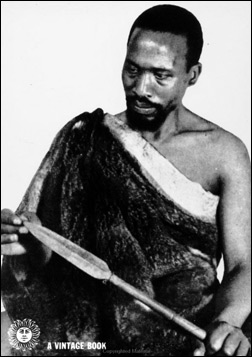
Jomo Kenyatta
It appears that the British attempted to smear the Mau Mau as Communists early in their revolt. Their top secret Information Research Department (IRD) looked for a way to tie the Kikuyus in with the Communist according to Paul Lashmar and James Oliver in Britain's Secret Propaganda War 1948-1977, Sutton Publishing, UK, 1998:
Given the economic plight in which Britain found itself at the end of the Second World War, it is no coincidence that the areas of the empire with the greatest economic value were those where Britain’s determination to maintain control was more obvious. Two such areas were Malaya and Kenya… White settlers on their farms in Kenya… declared whenever things went badly wrong that there was a red under the bed… Although IRD searched for a Communist angle on the Mau Mau, the evidence was not promising.
Jomo Kenyatta had visited the Soviet Union in 1932. Because he was an outspoken advocate of black liberation, the white settlers and colonial government assumed that he was a leader of the Mau Mau. This very tenuous thread to the Red threat was used by the British authorities.
The name "Mau Mau" was never used by the Kikuyu themselves, and did not exist in their language. In general, they called themselves the "Land Freedom Army," or the "Freedom Struggle Association." It may have been invented as part of a psychological operations campaign by the British like "Hun" or "Wog" in an attempt to demonize the Kikuyu people, make them less than human, and easier to hate and kill. It worked quite well. The name is still known today and signifies murderers and savages, although it has no meaning in the Kikuyu language. More interesting, the term has gradually entered the language. We find numerous quotes in literature such as "Are you trying to Mau-Mau me?" Apparently it is another term for pulling the wool over one's eyes. Tom Wolfe wrote a book entitled, In Radical Chic and Mau-Mauing the Flak Catchers. The term has also been used as a form of intimidation. Joseph Perkins used it in this way, "In past years the civil rights leadership would mau-mau the government or the corporate sector of the white "
In 1963 a theory arose that “Mau Mau” was an anagram of “Uma Uma” (“out out”), a codeword based on a secret-language game the Kikuyu boys played at the time of their circumcision. General China, a former Mau Mau leader did not support this theory and supposed instead that the native word for “Oath” is “Muma,” but because of its pronunciation the Europeans wrote it as "Mau Mau.” The leader of the movement, Dedan Kimathi, was opposed to the use of the term Mau Mau to describe the guerrillas. He preferred them to be called the Kenya Land and Freedom Army (KLFA).
The British used a form of psychological warfare in the way they wrote about and spoke about the insurgents. Caroline Elkins explores this in Imperial Reckoning, Henry Holt and Company, NY, 2005. She says:
Like most wars, Mau Mau was as much about propaganda as it was about reality…Equally powerful as the photographs distributed by the Colonial Office was the language used to describe the Mau Mau…the "white" and "enlightened" forces of British colonialism were in stark contradistinction to the "dark," "evil," "foul," "secretive," and "degraded" Mau Mau. These descriptions spilled over into the Kenyan and British press, where the sensationalist accounts juxtaposed white heroism with African, or Mau Mau terrorism and savagery.
In Winning Hearts and Minds – British Governments, the Media and Colonial Counter-Insurgency, 1944-1960, Susan L. Carruthers points out that the Foreign Office Information Research Department (IRD) tried to spin the Mau Mau as Communist backed but the Colonial Office Information Department would have none of it as there was no evidence of Soviet meddling. IRD was the British black propaganda unit set-up after World War II to counter the Communist threat.
The United States followed the uprising with great interest and Time magazine featured a two-page spread on the Mau Mau with a picture of a dead cat hanging from a tree with a note written in blood that any person who works for whites will be destroyed. The New York Times reported that the Mau Mau movement was a result of the frustrations of a savage people neither mentally nor economically able to adjust itself to the swift pace of civilization.
Other forms of psychological warfare included the British distributing radio sets to villages so that they could listen to pro-government propaganda broadcasts. They also published a number of propaganda newspapers such as The True News that branded the Mau Mau as spies, thugs, ruffians, gangsters, thieves, murderers, barbarians, and bandits.
Of course, the real story of the insurgency is not quite as "black and white." The British had ruled Kenya for many years and although they are generally considered among the more enlightened colonialists, the people of the occupied nation certainly desired and deserved independence. As in almost all such cases, the people and its political movements split into a number of different groups, some wanting a peaceful reconciliation, others believing that blood and terror is the only path to freedom. The Mau Mau was a breakaway wing of the main political party in Kenya, the Kenyan African Union (KAU). You might think of it like the Irgun, the terrorist wing that broke away from the Haganah (The underground Jewish Army) during the Israeli rebellion against British rule in Palestine. The president of the political party, Jomo Kenyatta, was imprisoned by the British in 1953. He had been arrested along with other Kikuyu leaders on 20-21 October 1952 as part of Operation Jock Scott. This had about the same result as jailing Gandhi had in India. In fact, Kenyatta, who campaigned for independence through non-violent means, was the one man who may have been able to stop the violence. He had a habit of appearing in public with a leopard skin and a spear, and this did not help his image in the West. Kenyatta was arrested and sentenced to seven years of hard labor for "managing the Mau Mau," incitement to violence and subversion. Three months before his
KAU is not a fighting union that uses fists and weapons. If any of you here think that force is good, I do not agree with you. Remember the old saying that he who is hit with a club returns, but he who is hit with justice never comes back. I do not want people to accuse us falsely - that we steal and that we are Mau Mau. I pray to you that we join hands for freedom and freedom means abolishing criminality. Beer harms us and those who drink it do us harm and they may be the so-called Mau Mau. Whatever grievances we have, let us air them here in the open. The criminal does not want freedom and land. He wants to line his own pocket. Let us therefore demand our rights justly. The British Government has discussed the land problem in Kenya and we hope to have a Royal Commission to this country to look into the land problem very shortly. When this Royal Commission comes, let us show it that we are a good peaceful people and not thieves and robbers.
The British controlled Kenya as early as 1890.There were over 30,000 British settlers in the country by 1930. By 1945, 3,000 European settlers owned 43,000 square kilometers of the most fertile land, only 6 percent of which they cultivated. This small minority ruled over a million Kikuyu tribe members. The African population of 5.25 million occupied, without ownership rights, less than 135,000 square kilometers of the poorest land. Many British farmers became wealthy through the growing and shipping of a fine African coffee. In order to protect their exclusivity, they banned the growing of coffee by the natives and introduced a hut tax. They also made it extremely difficult for those without land to purchase and hold a plot. This led to many of the Kikuyus leaving the rural areas and flooding the cities. This will always lead to unrest and political activism.
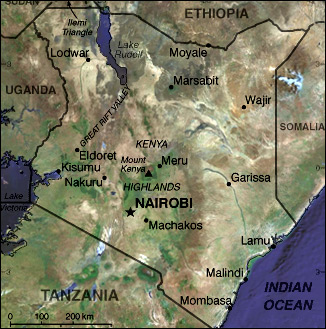
Map of Kenya
One became a Mau-Mau by taking the blood oaths. The power of the Mau Mau oath is hard to realize in our western culture. We have heard of the German Army's oath to Hitler, but that relied on the concept of honor. To the Kikuyu, the oath was not a point of honor; it was magical and had the power to kill. When two Kikuyus had a dispute they were brought before a witch doctor who had them both take an oath that they were telling the truth. It was understood that if you lied while repeating the oath you would die. So, the British realized that once the Mau Mau oath was taken, the terrorist would not willingly leave the group. That was why they had to use the same sort of "black magic" to invent a counter-oath that would free the individual from membership in the group.
There was also a great deal of peer pressure to take the oath. The leaders understood the power of personal relationships and tribal bonding and used it to force men to join the secret society. L. S. B. Leakey says in Mau Mau and the Kikuyu, The John Day Company, NY, 1952:
Mau Mau followers were forbidden to invite non-members to drink beer, or to attend their dances; they were not to help them in building huts or in any other tasks where it was normal for a man to call on his neighbors to give communal aid. Thus, many who had been reluctant to join the Mau Mau in its earlier days, were more easily persuaded to do so as time went on…
Although there is little mention in the literature of the actual oath, it is known that the ceremony began with the new members taking a vow to honor the old religion of their tribal ancestors. Once past that stage, it is impossible to know how much of the oath is real and how much is British propaganda. The colonial secretary, Oliver Lyttelton, wrote in part:
The Mau Mau oath is the most bestial, filthy and nauseating incantation which perverted minds can ever have brewed. I have never felt the forces of evil to be so near and as strong as in Mau Mau. As I wrote memoranda or instruction, I would suddenly see a shadow fall across the page – the horned shadow of the Devil himself.
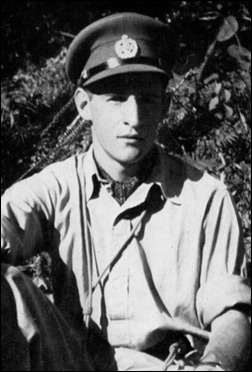
Major Frank Kitson (later General)
In Gangs and Counter-gangs, Barrie and Rockliff, London, 1960, Major Frank Kitson mentions a Mau Mau raid where body parts of an old African were taken to be used in the oathing ceremony later:
The gang, frenzied by the thought of blood, slashed around with their simis (a Kikuyu sword) and fired their guns. One old man, slower than the rest, was caught and hamstrung. He fell at the feet of his pursuers, covering his face with his arms to protect it from the slicing swords, but a mouse in a mechanical mincing machine would have had a better chance of survival. One terrorist hacked off a foot, and another sliced off his testicles to use later in an Oathing ceremony. A third gouged out his eyes with a staple and put them in his pocket for the same purpose. When they had finished, most of the gang came by to cut and stab the twitching corpse. They then licked the blood off their simis and moved off into the night, having first set fire to all the huts they could see.
Other writers have stated that there were at least seven stages of oath-taking, which might take several days or weeks to complete and which could include the drinking of blood, eating portions of human flesh, cohabiting with animals, and ingesting bits of brains from disinterred corpses. After the seventh stage of the oath-taking had been reached, the members had to repeat the cycle and reinforce their vows by beginning again.
There may be some truth to the use of sex and perversion in the oath. Some experts believe it was a form of psychological warfare used by the leaders to assure that the soldiers could not fall under the control of their village elders and chiefs. Sexual perversion is taboo in all contexts so far as the Kikuyu tribe is concerned. By forcing the members of the Mau Mau to perform such sexual activities, they were filled with guilt and self-loathing and ashamed to return to their village. It tied the fighters to the insurgency forever.
Other sources make the oath sound more conservative. One gives an example of what he thinks the oath probably was:
I swear that I will fight for the African soil that the white man has stolen from us. I swear that I will always try to trick a white man and any imperialist into accompanying me, strangle him, and take his gun and any valuables he may be carrying. I swear that I will offer all available help and further the cause of Mau Mau. I swear that I will kill, if necessary, anybody opposed to this organization.
A second source claims that the oath was as follows:
I speak the truth and vow before God
And before this movement,
The movement of Unity,
The Unity which is put to the test
The Unity that is mocked with the name of 'Mau Mau',
That I shall go forward to fight for the land,
The lands of Kirinyaga that we cultivated,
The lands which were taken by the Europeans.
And if I fail to do this
May this oath kill me...
The members took one oath when they joined and another when they went into the forest and away from their villages and homes. The second oath allegedly was:
I speak the truth and vow before our God:
If I am called to go to fight the enemy
Or to kill the enemy I shall go,
Even if the enemy be my father or mother,
My brother or sister
And if I refuse
May this oath kill me...
After a time everyone was forced to take the oath again. Soon, the oaths began to lose power because of the constant repetition. Even worse for the guerrilla, each time they took the oath they were charged thirty or forty shillings for the privilege of joining a society of which he was already a member. It became clear to many of the disenchanted fighters that this magical oath was just a way for the leadership to raise funds. Worse for the Mau Mau leaders, as the members left the organization and did not suffer a painful and agonizing death, it became clear that the oath had no magical power and was just a myth.
There was also a leadership oath. It is mentioned by Donald Barnett in Mau Mau from Within, Monthly Review Press, N.Y., 1966:
I swear before God and all the people here that…
1. I will never reveal the leader's secrets to a warrior or any other person not a leader.
2. I will never run away or surrender leaving my warriors behind.
3. I will never abandon the leadership of my people but I will go wherever my people world send me and do whatever they ask me to do in my country's name.
4. I will never disdain and leader in the presence of warriors.
5. I will never by any means cause or plan the injury or death of another leader.
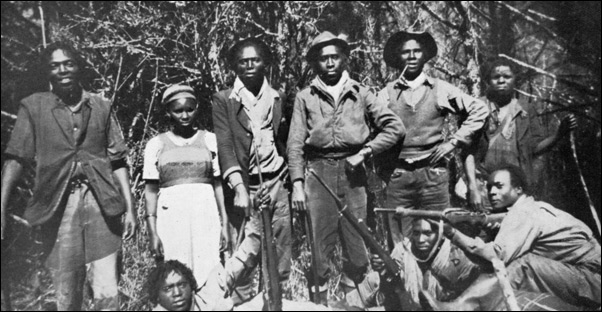
A Mau-Mau gang, (note the home-made rifle held by the man on the far right).
It is also interesting to note that when the British captured a Mau Mau, understanding the solemnity of the oath, they forced the prisoner to take a counter oath, often led by government-sanctioned "Her Majesty's Witch Doctors" that would allow the individual to walk away "cleansed" from his earlier blood oath with some justification and religious legality. Another form of cleansing oath was performed by Christian Ministers. The Terrorist would hold a Bible in his hand and swear eternal enmity to the Mau Mau and loyalty to the Kenya Government.
Kenya is only about six hundred miles long and four hundred wide, but just a small area, about one hundred miles by seventy miles was affected by the rebellion. This was the country occupied by the Kikuyu tribe and the European lands nearby. The Kikuyu tribe is the largest in Kenya. Together with the Embu and Meru, it numbered about one and three quarter million people in 1953.
The actual rebellion occurred from October 1952 to December 1959 and is sometimes dated from the murder of the British loyalist Kikuyu chief Warihiu who was speared to death in broad daylight on a main road on the outskirts of Nairobi. He had spoken out against increasing Mau Mau terrorist acts against colonial rule. The uprising could be called a failure because the Kikuyus did not win a military victory against the British. However, just as happened in Rhodesia, the conflict created a rift between the British government and the more militant British settlers in Kenya. This would lead to the United Kingdom granting Kenya independence in 1963. The Mau Mau had few weapons other than firearms captured from raids on police stations. In general, their weapons were traditional; clubs, knives, spears and arrows. Like the Viet Cong in later years, they attempted to make guns from old pipes, door bolts, wood, nails and elastic bands. They could not fight in the open battlefield with the better-armed British so they engaged in guerilla warfare and terrorism. They launched raids on settlers' farms, post offices, police stations, and other Kikuyu perceived as being loyal to the regime. The British retaliated with public hangings, which had been outlawed in Britain for over a century. A mobile gallows was transported around the country dispensing justice to Mau Mau suspects. Dead insurgents, especially commanders, were displayed at cross-roads, at market places and at administrative centers.
David Anderson mentions the killings in Histories of the Hanged, W. W. Norton and Company, N.Y., 2005:
Kenya's hanging judges were kept busy. Between April 1953 and December 1956 the Special Emergency Assize Courts tried a total of 2609 Kikuyu on capital charges relating to Mau Mau offenses in 1211 trials. Around 40% of those accused were acquitted, but 1574 were convicted and sentenced to hang over this period…In total approximately 3000 Kikuyu stood trial between 1952 and 1958 on capital charges relating to the Mau Mau movement…In all, 1090 Kikuyu would go to the gallows…
The actual number of white civilians killed during the uprising was 32, while the number of African civilians killed by Mau Mau was officially put at 1,819. Of the insurgents, it is believed that 11,000 were killed and more than 1,000 were hanged as criminals.
The supreme Mau Mau body was the Central Committee. Attached to the Central Committee was the War Office and Headquarters of the Land Freedom Army. This had authority over all the terrorists in the Colony and its chairman was officially known as the Commander in Chief, Kenya. There were other committees representing every district in the native Reserves under the Central Committee. The main job of the Committees was to collect arms, ammunition, money and recruits.
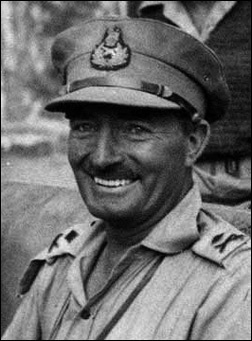
General Sir George Erskine
During the uprising Kenya was under a state of emergency and the governor requested and obtained British and African troops. In November 1952 the British closed 34 Kikuyu schools. By May, 1953 General Sir George Erskine was appointed commander-in-chief of the colony's armed forces.
According to Anthony Clayton, writing in Counter-Insurgency in Kenya 1952-60, Sunflower University Press, Kansas, 1976:
Erskine had been a personal friend of the Prime Minster for many years and was briefed on his task personally by Churchill before his departure…Erskine has been surprisingly neglected by students of military history and counter-insurgency tactics. As an efficient and highly principled commander, he deserves closer study.
Erskine seems not to have cared for the Kenyan European settlers, some of whom used the emergency to settle old scores, steal African lands, and murder suspected terrorists without trial. Clayton adds:
Erskine viewed the Kenya settlers very poorly. "Kenya is the Mecca of the middle class…a sunny place for shady people…I hate the guts of them all…I dislike them all with few exceptions."
A Home Guard was recognized as a branch of the security forces and allowed to take action against prospective Mau Mau members. This led to abuses as it always does and about 4,686 suspected Mau Mau were killed by the Guard alone. The government encouraged the white settlers to take up arms against the insurgents. The settlers set up their own vigilante groups to protect their farms from the rebels. They often hired other Africans to do their killings for them and shot suspected terrorists with impunity. The Home Guard took whatever they wanted from families who supported the Mau Mau. Others threatened to denounce loyal Kikuyu unless they were given bribes. Theft, intimidation, torture, castration and rape were commonplace.
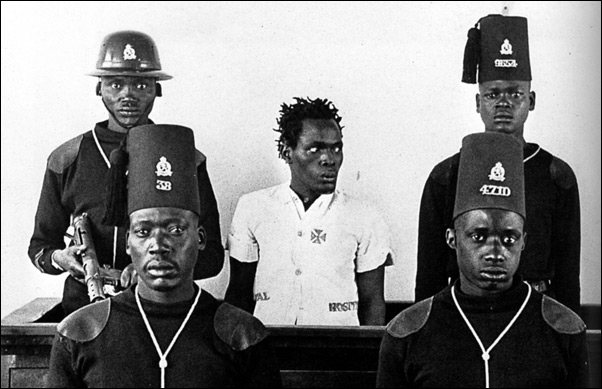
Waruhiu Itote, aka "General China", in the dock at Nyeri.
The first notable capture of a leader occurred in January 1954 when the British caught Waruhiu Itote, also known as "General China." By March 1954 the British had captured General Katanga and General Tanganyika. On 24 April 1954 the British launched Operation Anvil. The Kenyan capital city of Nairobi was placed under military control, the 100,000 African occupants taken and 70,000 Kikuyu screened and 30,000 suspected of being Mau Mau members or supporters moved to detention camps and "protected villages." Among those arrested were 5000 British-paid native troops and 1000 Kikuyu Policemen. It is interesting to note that the Italians tried this in Libya and the Americans in Vietnam. This attempt to cut off the rebels from their supply and economic base seldom works, though the British did have some luck with it in Malaya in 1950.
Apparently the British dropped leaflets on Nairobi at the time. According to one published report the sky over Nairobi was filled with British aircraft on 24 April 1954, dropping leaflets that warned residents to stay indoors. 19-year-old Waititu Mwangi picked up one of the leaflets. It said that all members of the Kikuyu, Embu and Meru tribes should immediately leave their houses with their hands up and surrender to soldiers on the streets.
By the end of 1954, one-third of all Kikuyu men were said to be in prison. These detainees had not been convicted of any crime and were held without trial. By October 1955 over 70,000 Kikuyu tribesmen suspected of Mau Mau membership have been imprisoned, and over 13,000 people had been killed in all by both British troops and Mau Mau soldiers since the start of the rebellion. In October 1956, the British captured Field Marshal Dedan Kimathi after a three year manhunt. That effectively signified the doom of the uprising. Believed to be responsible for at least 29 killings, Kimathi was officially charged with the unlawful possession of a revolver and six rounds of ammunition and hanged on 19 February 1957.
The British used some interesting intelligence and psychological warfare tactics to fight the insurgents. Pentagon counterinsurgency advisor John
When conventional military operations and bombing failed to defeat the Mau Mau insurgency in Kenya in the 1950s, the British formed teams of friendly Kikuyu tribesmen who went about pretending to be terrorists. These "pseudo gangs," as they were called, swiftly threw the Mau Mau on the defensive, either by befriending and then ambushing bands of fighters or by guiding bombers to the terrorists' camps.
What is not mentioned, either accidentally or on purpose is that these gangs were often made up of former terrorists who had defected or surrendered to the British and been "rehabilitated." Like the Hoi Chanhs and Kit Carson Scouts in Vietnam, these ex-terrorists with their dreadlocks knew all the tricks and could easily pass for Mau Mau members, allowing them to gather much useful information and set up ambushes.
Major Frank Kitson thought up the idea of using defector Mau Mau to infiltrate the gangs in the forest. He tells of a former terrorist named James who joined the government patrols.
Most of the time James had just shown the Field Intelligence Assistants (F.I.A.) places where they could ambush the gangs or pick up supporters. On one or two occasions, however, he had been released and had gone back to groups of terrorists who did not know that he was a prisoner. He had then been able to give the F.I.A. concerned accurate information as to exactly where they were. Once he took command of a small group of Mau Mau which he found, and led it into an ambush!
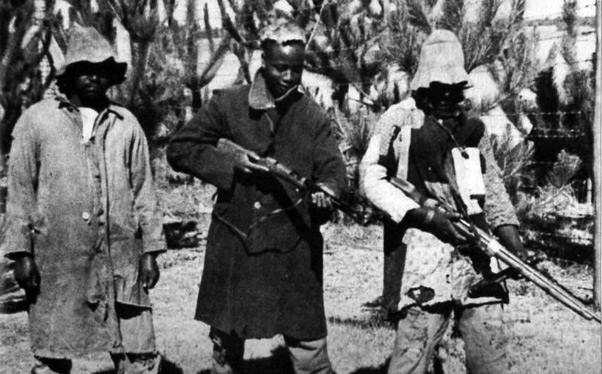
The Two "Pseudo gang" members at the left are ex-Mau Mau, the man at the far right is a white British soldier disguised as an African.
Michael Dewar tells us more about Kitson in The Art of Deception in Warfare, David and Charles, UK, 1989:
Kitson had stumbled on the idea while interrogating a captured terrorist who showed a remarkable willingness to turn informer on his erstwhile comrades. Frank Kitson had arrived in Kenya in August 1953. In March the following year he heard that a British Intelligence Officer called Hales had had an extraordinary experience. He had been in the bush with several of his African helpers when the group suddenly found themselves surrounded by several hundred Mau Mau insurgents. Hales, realizing that he was bound to be recognized, walked a short distance away and crouched down behind some scrub. The Africans with Hale pretended to be Mau Mau supporters and they all - to their amazement – got away with it. Kitson was quick to recognize the significance of this event. Because they did not expect to see a white man, they did not notice Hales. Kitson decided to cash in on the insurgents' gullibility by training Africans, particularly ex-Mau Mau, to impersonate gangsters as a regular means of getting information.
Kitson and the Pseudo gangs are mentioned again in the 2005 Lawrence E. Cline monograph Pseudo Operations and Counterinsurgency: Lessons from Other Countries:
Most of the officers and noncommissioned officers had little or no formal intelligence training or background. Frank Kitson, who was key in developing the concept of pseudo-guerrillas in Kenya, noted the attitude of his superiors when he was appointed as a District Military Intelligence Officer: "If we could not be of any use, could we please not be a nuisance?"
Kitson's original concept was simply to develop camps in which the British "could keep a handful of Africans who could help with his interrogations and who could move around the countryside planting . . . and visiting informers." In rather short order, however, he discovered that captured Mau Mau were willing to work actively against their former comrades. Former Mau Mau were used to train British African troops and deployed with these troops in the field against the insurgents.
Cline also mentions that the unit members could be used for intelligence and identification purposes. He says:
When they were all safely hidden behind their masks, they would be assembled and sat down in a row of chairs, with one of our men standing behind each one. No hooded man was allowed to talk to another. When all was ready, the suspects would walk past the hooded men. If they recognized anyone they would give brief particulars to the Field Intelligence Agents (FIA) standing behind their chair. If a suspect was recognized by three or four of the hooded men and if the particulars given to the FIAs corresponded, then it was a safe assumption that they had picked the right man. In this way, we collected a lot of information about people, and we also caught many senior Mau Mau supporters. Quite often we would even get active gangsters in the net.
Cline concludes:
Money Counts. In most cases of successful use of pseudo operations, money in one form or another has been a key component of the campaign. Cash rewards both for civilians to turn in insurgents and for insurgents to surrender have provided the basis for the respective governments to seize the guerrillas. This, of course, is the first step in being able to "turn" them. Rewards for turning in guerrillas, usually "dead or alive" were used in Malaya, the Philippines, Kenya, and Rhodesia. In a number of cases, reward money was sufficiently ample that guerrilla leaders would turn in their own troops. In some cases, both cash rewards and relocation were offered to surrendered guerrillas.
Although they were gradually winning the war against the insurgents, the reputation of the British suffered around the world. On 3 March 1959, 85 prisoners were marched out to a worksite. When the prisoners refused to work, prisoner John Maina Kahihu described what happened:
We refused to do this work. We were fighting for our freedom. We were not slaves.
There were two hundred guards. One hundred seventy stood around us with machine guns. Thirty guards were inside the trench with us. The white man in charge blew his whistle and the guards started beating us. They beat us from 0800 to 1130. They were beating us like dogs. I was covered by other bodies. Just my arms and legs were exposed. I was very lucky to survive. But the others were still being beaten. There was no escape for them.
The British beat 11 men to death and another 60 were seriously injured. The prison officials attempted a cover-up by claiming that the men had died from drinking contaminated water, but the story found its way back to London. There was a political uproar. Now it was the British and not the terrorists that were exposed as brutal thugs. Within weeks, London closed the Kenyan camps and released the detainees.
As so often happens, at the end of the rebellion the hardcore terrorists gained little benefit from independence. Like the Viet Cong after the independence of Vietnam, the new government had little use for terrorists and murderers, even if they believed themselves to be freedom-fighters and patriots. In the newly independent Kenya, they were excluded from high positions and political appointments. These positions were given to the English-educated, well-bred, and wealthy Africans. Kenya simply replaced the white elite with a black one.
On 10 November 1959 the state of emergency was ended in Kenya. Jomo Kenyatta, now aged 71, was released from house arrest in July 1961. He was elected Prime Minster in May 1963. Kenya became an independent African state on 12 December 1963. Four days later a general amnesty was announced for all Mau Mau activists. On 12 December 1964 Kenya was declared a republic and Jomo Kenyatta was its first president.
In 1999, veterans of the Mau Mau rebellion demanded billions of Kenyan shillings in compensation from the British government for war crimes committed against them. They asked that the British government admit responsibility for the loss of life, property and the pain inflicted upon hundreds of thousands of Kenyans during the war.
PSYOP LEAFLETS
In the September 1959 issue of the PsyWar Society's Falling Leaf Peter H. Robbs first mentioned the British propaganda leaflets. He said:
During the course of the Mau Mau disturbances various leaflets were disseminated; the most important being yellow "safe conduct passes" in January of 1955 incorporating the very controversial pardon for past crimes. While certain successes were obtained, about 300 surrenders up to April 1955, the press reported that the Mau Mau chiefs were having a purge of waverers by killing all their supporters who were found with these leaflets in their possession, so that in some cases they became death warrants instead of life insurance. Scores of gangsters were found in the forests of Kenya shot or slashed to death. In a deliberate attempt to avoid this; the later leaflets stated that a green branch was to be the sign of surrender, not the actual leaflet.
In 2006 a pair of British propaganda leaflets aimed at the Mau Mau surfaced. The leaflets were originally in the collection of the British propaganda specialist Francis J. Field, author of the book Aerial Propaganda leaflets.
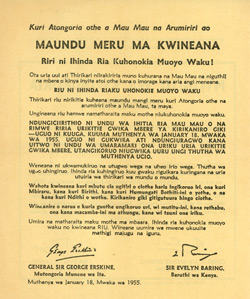 |
This leaflet is all text and signed by General Sir George Erskine, Commander-in-Chief, and by Sir Evelyn Baring, Governor, on January 18, 1955. The leaflet was printed by The Government Printer in Nairobi for The Department of Information of Kenya. The 193 x 230mm leaflet promises fair treatment for terrorists who surrender. Some of the text in English, Gikuyu and Swahili is:
The Commander in Chief's and Governor's signatures at the bottom certifies that anyone who surrenders will not be punished.
An Oath not to punish whoever surrenders
THE BEARER OF THIS PASS WISHES TO SURRENDER. He is to be given fair treatment, food, and medical attention if needed. He will be detained but he is NOT to be prosecuted for any offenses connected with the Emergency which he may have committed prior to 18 January 1955.
There is a long message on the back. Some of the text is:
To all the Mau Mau leaders and their followers
NEW DIRECTIVES CONCERNING THOSE WHO INTEND TO SURRENDER
This is the time to save your soul!
As you know, the government has put great effort in the fight against the Mau Mau and it will continue to pursue and kill those who refuse to surrender.
THIS IS THE TIME TO SAVE YOUR SOUL.
The government has continued to issue directives like this to the leaders and followers of the Mau Mau.
If you surrender today and give up all your weapons you will indeed save your soul.
YOU WILL NOT BE PROSECUTED BECAUSE OF THE MISDEEDS OF THE MAU MAU, NOT EVEN ONCE, IF YOU AGREE TO HONOR THIS OATH. THIS APPLIES AS OF 18 JANUARY 1955. THIS IS A PROMISE TO YOU THAT YOU CAN NOT BE KILLED OR HANGED DUE TO YOUR PREVIOUS INVOLVEMENT WITH THE MAU MAU AFTER YOU AGREE TO SURRENDER, ON THE CONDITION THAT YOU NOT REJOIN THE MAU MAU AFTER 18 JANUARY 1955.
This may or may not be the leaflet mentioned by Donald Barnett as related by Karari Njama, a Guerrilla leader:
On 18 January we went to visit Gicuki Wacira who lived on the same slop about one mile into the forest fringe. On our way we heard an airplane sky-shouting [loudspeaker] an appeal for us to surrender. As it passed us following the forest border, we saw it dropping thousands of leaflets. I sent one of my escorts to get me a leaflet. It read –
Government promise
The Kenya Government has offered all the fighters a chance to come out of the forest and return to the normal peaceful life. His Excellency the Governor of Kenya Sir Evelyn Baring has given a general amnesty up to today, 18 January 1955. Save your life now! Surrender with all your fighting weapons and you will not be prosecuted. You will be detained and received good medical treatment, food, clothing and general care.
(Signed by) Sir Evelyn Baring
His Excellency the Governor of Kenya
General Sir George Erskine
Commander-in-Chief, East Africa
The campaign is also mentioned in Mau Mau Memoirs, Marshall S. Clough, Lynne Rienner Publishers, Boulder and London:
In January 1955, the government declared a two-week ceasefire and sent planes over the forest to sky-shout and drop leaflets offering an amnesty if the Mau Mau surrendered.
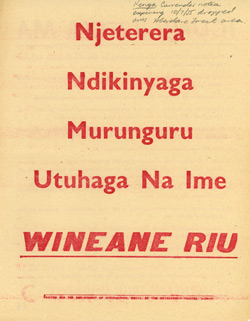 |
The second leaflet is a British safe conduct pass leaflet directed to the participants of the Mau Mau Rebellion. The leaflet was printed by The Government Printer in Nairobi for The Department of Information of Kenya. The leaflet was dropped over the Aberdare Forest area, and it is a surrender offer which was to expire on 10 July 1955. The leaflet measures 172 x 219mm and is in red text. The text contains twelve numbered statements in regard to the uprising and the treatment of those who return to the government. The text is:
12 FACTS THAT ARE TRUE
(1) It is known that most of you are willing to surrender, but the agreement to surrender dating 18 January will expire 10 July 1955.
(2) You have only 7 days left to act upon the agreement that will save your souls and your land.
(3) You will be hunted and killed wherever you are if you do not surrender yourselves.
(4) The government is acting in good faith. Those people who surrender themselves before 10 July 1955 will be awarded in addition to securing their land and their property.
(5) If you do not surrender your people will starve and your children will face unending suffering.
(6) 877 smart people surrendered since 18 January1955.
(7) 1281 Mau Mau insurgents have already been killed, and 625 have been arrested. In addition hundreds of thousands more in the reserves and homesteads have concluded that after 16 January there will be no hope to survive for those who do not surrender.
(8) Your leaders have lied and mislead you. They are the reason why the previous oaths for surrender failed.
(9) Be warned that your leaders who disagree among themselves may sacrifice you in their bid to save themselves.
(10) Those sympathizers that were assisting you in the reserves and the homesteads have lost hope and given up, and have decided to save themselves.
(11) You have no future in remaining in the forest, only suffering and death and your descendants will forget you.
(12) When you are been mislead by those that assist you, lied to by your leaders, cursed by your tribal family, and lied to god, the only possible choice is,
SURRENDER AND YOU WILL BE SAVED
The back of the leaflet bears an old Kikuyu proverb. The meaning of the proverb is that those who wait will never get where they were going, but will race in vain to get where they want to go and end up disappointed and covered with dew. The final line is "Give yourself up now."
Note: Even before the uprising several hundred Kikuyu were living in the forest which covered the slopes of Mount Kenya and the Aberdares. Many of them were wanted fugitives and bandits. After the start of the emergency, more natives joined them as they left home fearful of arrest by the British or because they were ordered there by the rebel leaders. This large group of criminals, patriots and displaced persons gradually formed into several groups; the Militant Wing and the Passive Wing. The Militant Wing lived mostly in the forest and consisted of gang members. The Passive Wing comprised those people who provided money, supplies, shelter, recruits and intelligence for the gangs. The Aberdare gangs whose members came from the District of Nyeri were known as the Ituma Demi Armies,
On 18 January 1955 the Governor-general of Kenya, Sir Evelyn Baring, offered an amnesty to Mau Mau terrorists. The European settlers were up in arms at the leniency of the offer. The offer was withdrawn on 10 June 1955.
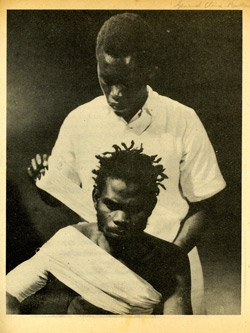 |
A third leaflet from the collection of British PsyWar specialist Dr. Rod Oakland depicts a wounded General China being bandaged.
General China (Waruhiu Itote) was the first of the senior Mau Mau guerrilla leaders captured by the government. He was the second in command of their military wing. His legend says that he had been stationed in India as a member of the British Army during WWII and learned how the Haitians had risen in a slave insurrection. A second anecdote has him being lectured on African freedom while helping to put down a revolt in Uganda. In late 1950 he took the Mau Mau oath. He was first assigned 40 men and trained them in the tactics he had learned fighting the Japanese in Burma. Later he led a large guerrilla force of about 4000 soldiers on Mt. Kenya.

Self-styled 'General' China, terrorist leader, being taken to hospital after
being wounded and captured by Security Forces
The General was wounded in a battle with government troops on 15 January 1954 while on a raid to obtain weapons. After a brief hospitalization, he was declared fit for interrogation. China was interrogated for a total of 68 hours by Ian Henderson at the office of the Special Branch of the Kenya Police. He eventually agreed to help arrange for peace talks between the government and the insurgents. There was a three-month lull in fighting during which time the Special Branch gathered extensive intelligence about the passive wing that supplied food, money, volunteers and ammunition to the fighters. When the "China Peace Overture" failed, the British swept in and arrested more than a thousand Mau Mau suspects in three days. General China was tried and sentenced to death at one point, later given solitary confinement and hard labor, and was finally released from jail by the new Kenyan leader Jomo Kenyatta on 14 June 1962.
The General China leaflet is mentioned in Mau Mau from Within:
Government airplanes spread in the air thousands of leaflets containing General China's photo, and the airplanes appealed to our fighters through their loudspeakers to surrender, taking green branches with us. The surrender appeal said…"Today your food is being brought; it is the gift of bombs. Surrender today, carrying a green branch. Take the road leading to ----- with your arms and you will be welcomed by the Devons [Devonshire Regiment]."
A warrior returned with one of the leaflets containing General China's photo. It said that an important leader had been captured and that there was no use in our gang going on fighting. We discussed the leaflet, agreeing that it was another government propaganda trick.
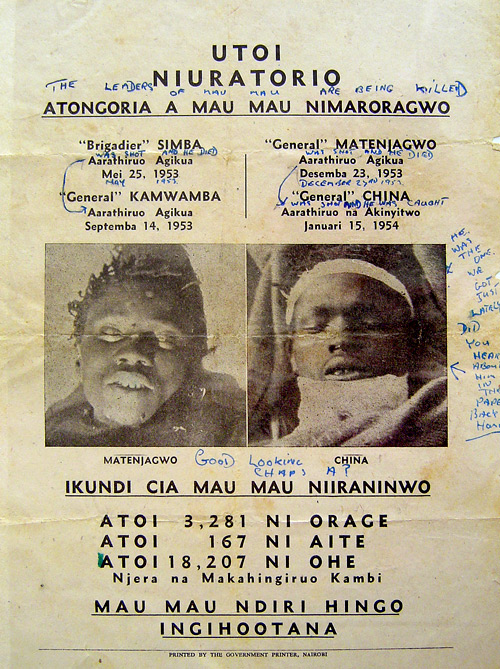
The Leaders of the Mau Mau are being Killed
A member of the Royal Kent Regiment picked up this leaflet in the Aberdares in 1954. The infantry unit considered the tour a great success and claimed 290 Mau-Mau killed, 194 captured and 114 firearms seized. The Aberdare Range is a 99.4-mile long mountain range north of Kenya’s capital of Nairobi with an average elevation is 11,000 feet.
Notice that his translator wrote the English-language text directly on the leaflet. The leaflet mentions three Mau Mau leaders who were killed in action and one that has been captured. It states that generals Simba, Kamwamba and Mateniagwo were shot and killed during 1953 and General China was shot and captured on 15 January 1954. It depicts the dead General Mateniagwo and the injured General China.
An additional leaflet seems to be mentioned in Mau Mau Memoirs:
Another leaflet operation occurred in 1956 when the Government crisscrossed the forest skies, sky-shouting for the guerrillas to surrender and dropping leaflets threatening to confiscate their land and property.
On the 27 June 2009 BBC Radio Four show, "Saturday Live," Tim Symonds talked about his early life in Kenya.
At just 17-years of age Tim Symonds went to Kenya in an attempt to get away from school and broaden his horizons. He was hired to work on a farm in Kenya and was amazed to find that there was a Mau Mau rebellion taking place. He spent one year working on the farm and said that he would often look for vultures during breakfast because the Mau Mau would come out of the forest during the night hours and kill sheep or cattle for food. They would always disappear back into the forest before dawn when they were vulnerable to military aircraft or vehicles.
In regard to leaflet operations he said in personal conversation:
The thing I most remember was watching leaflets being dropped and the farmer I worked for saying that most of the Mau Mau couldn't read and would have to have the leaflet read to them by the often literate leadership, who may have told them quite the opposite of what the leaflets offered. I myself saw Mau Mau straggling out of the forest carrying the requisite branch to show they wanted to surrender. This entitled them to a de-oathing ceremony followed by a grant of some land and hut-building materials.
After one year as a farmer, Tim joined the Kenya Police Reserve, (KPR), and became a tracker team leader. His job was to keep the Mau Mau moving. He said; "If you move you starve," so he attempted to keep the insurgents on the run where they would be unable to gather foodstuffs to survive. Several of the Mau Mau leaders had £5000 rewards on their heads and Tim said that he would often spend 12 straight hours in the field trying to capture those very valuable prisoners.
At one point it became clear that the various gangs in the forest were so isolated that they did not recognize each other. Tim was called into headquarters and told that he was to become a member of a "Pseudo Gang" and would patrol with two former Mau Mau members who had returned to the government side. He was selected because he had brown eyes. However, because he also had white in his eyes (the sclera), he would place a tiny drop of black shoe polish in the corners of his eyes each day to darken the white area. This would work for several hours and then the polish would be replaced, causing great pain from the alcohol in the solution. He was given a filthy pair of old torn clothes that might have been from a British WWI uniform. He made the mistake of washing them in the detergent Tide and both his former insurgents told him from 30 yards away that he would get them all killed since they could smell the soap on the clothes. He was forced to return to the supply depot and find another set of foul and nasty clothes.
During one mission in the bamboo forest he captured a 50 or 60-year-old insurgent named Obama who spoke perfect English. That is clearly not a Kikuyu name and Tim has written to the American Embassy trying to discover if this was the grandfather of U.S. President Obama.
PSYOP PUBLICATIONS
|
| |
The Mau Mau in Kenya | ||
In all the many British wars against insurgencies they produced booklets and publications depicting the atrocities of the enemy in an attempt to convince both citizens and neutral countries of the bestial nature of the terrorists and the need to take strong action to preserve the peace. An example is the propaganda booklet The Mau Mau in Kenya. This booklet is described by Susan L. Carruthers in Winning Hearts and Minds: British Governments, the Media and Colonial Counterinsurgency, 1944-1960.
…without actually reproducing images of Mau Mau atrocities, several contemporaneous writers on Mau Mau asked their readers to believe that such photographs would remove any misconceptions that it was a nationalist movement. Stoneham, for example, wrote that their "hideous corpses cry out, not for 'conciliatory measures', but for vengeance on their slayers." His proposition that such images "could never be produced for general publication . . . though it would be salutary to send copies of these nauseating pictures to those who suggest a compromise with this infamous gang of savages" was, unknowingly, close to official policy. However, there were occasions on which the British and Kenya governments did make atrocity photographs more widely available. For example, in 1954 an anonymous pamphlet entitled The Mau Mau in Kenya was published, which was almost entirely devoted to horrific images of Mau Mau terrorism, and was clearly a government production, given its preface by Granville Roberts.
This ends our brief look at the Psychological Operations during the Mau Mau insurrection. I have tried to be fair and impartial in this report but it is understood that readers who were personally involved in the struggle will feel strongly one way or the other. I encourage readers with comments to write to me at Sgmbert@hotmail.com. I would especially like to see more of the leaflets dropped on Kenya. I am sure that many exist among the souvenirs of old soldiers.
04 January 2006
Kenya And the Barbaric Face of the British Empire
10 April 2011
Nairobi — One horrific day in September 1957, Ndiku Mutwiwa Mutua claims, he was castrated by the British Government.
Last week the elderly Kenyan appeared in the High Court in London, along with three others to accuse Britain of being liable for what was done to him 54 years ago, and to demand compensation.
The case of Mutua and others versus the Foreign and Commonwealth Office (FCO) relates to events that took place at the height of the Mau Mau emergency -- the uprising against colonial rule in Kenya between 1952 and 1960.
The Mau Mau rebellion was one of the nastiest chapters in British colonial history. Appalling atrocities were perpetrated by both sides, but few stories of cruelty are worse than that of Mr Ndiku Mutwiwa Mutua.
In 1956 Mr Mutua was a 24-year-old herdsman working for Mr Louvaine Dunman, a white settler in Kenya's Eastern Province. Mr Dunman, a police officer in the district force, was known as "Luvai" among the Kamba people who couldn't pronounce the name Louvaine properly.
While working on Mr Dunman's farm, Mr Mutua began supplying food to the Mau Mau rebels hiding out in the nearby forest. On or before September 17, 1957, he was arrested by Mr Dunman and five other African police officers.
According to a court document, he was repeatedly beaten by European and African officers alike and then taken, blindfolded, to a tent.
Inside, he was allegedly handcuffed and pinned to the ground, with his legs pulled apart and tied or strapped down.
"Having been rendered completely powerless and vulnerable," according to the document, Mr Mutua claims that he was "castrated by one or more of the officers present".
For two days he was allegedly left without medical attention and then liberated from the camp by Mau Mau rebels. He remained in the forest for three-and-a-half years before the rebellion ended and he returned home.
Mr Mutua claims that he suffered depression, anguish, mental stress, and "intense flashbacks to the episodes of assault, including castration (and) mourned the fact that he will never have children of his own and never be with a woman".
Like his fellow claimants, Mr Mutua holds the British Government responsible for his suffering. Another of the plaintiffs also claims to have been castrated, while a third was allegedly beaten and left for dead during the infamous Hola Camp massacre of 1959 in which 11 detainees were clubbed to death.
The only woman claimant said that she was subjected to sexual torture in which she was violated using bottles filled with hot water.
The alleged mistreatment of another claimant, Mr Wambugu wa Nyingi, carries echoes of waterboarding. Mr Nyingi claims that he was "suspended by his feet from the hut roof. He was then subjected to a severe beating over a period of about 30 minutes, while cold water was poured on to his face and into his mouth so he could not breathe".
The claimants' case rests on the argument that these acts of brutality were not isolated or random, the spontaneous cruelty of a few sadists, but a systematic policy organised and condoned by the British authorities, "part of a system of torture, inhuman and degrading treatment applied by police, home guards, and other members of the security services with the knowledge of the colonial administration.
"Many detainees were subjected to gross abuse and torture," say the claimants.
"Such abuse included whippings, beating, castration, and sexual abuse of men and women... in many cases the abuse and torture were so brutal and dangerous that the detainee died."
Lawyers representing the British Government argue that the case should be dismissed because the alleged abuse was carried out by the colonial government, which passed all rights and responsibilities to the independent Kenyan Government in 1963.
When Kenya assumed national sovereignty, government lawyers will argue, this included an implicit acceptance of liability for any outstanding claims against the national administration.
The Kenya Government flatly denies any liability. A letter was sent to British Foreign Secretary William Hague on March 31 stating: "The Republic of Kenya fully supports the claimants' case and has publicly denied any notion that responsibility for any acts and atrocities committed by the British colonial administration during the Kenya 'Emergency' was inherited by the Republic of Kenya."
Among those rounded up in the run-up to Mau Mau was Hussein Onyango Obama, Barak Obama's paternal grandfather, who became involved in the Kenyan independence movement while working as a cook for a British Army officer after the war.
He was arrested and jailed for two years in a high security prison where, according to his family, he was subjected to horrific violence to extract information about the growing insurgency.
Further light will be shed by the newly discovered Foreign Office files relating to Mau Mau, which were deliberately removed from Kenya.
On December 3, 1963, nine days before Kenya formally declared independence, three wooden crates containing 1,500 highly sensitive government files were loaded on to a British United Airways flight bound for Gatwick.
A memo written by one Foreign Office official noted that the removal of the documents had been carried out in "meticulous fashion", with files selected on the specific grounds that their contents "might embarrass Her Majesty's Government, members of the police, military forces, public servants, or others".
In a memo marked "Most Secret", the Foreign Office noted that "the vast majority of the files concern the Emergency: eg, intelligence reports and summaries, African associations, activities of Africans, unrest in the districts etc . . . collective punishments, detainees and detention camps".
In 1967, the Kenyan Foreign Ministry asked the British Government to return the missing files. The FCO refused.
A confidential FCO memo written on November 2, 1967, warned that if the documents were sent back to Kenya, it could "set a precedent and encourage other governments to follow suit" and demand "the documents of other former Dependent Territories which are now held here".
A letter on the same subject from the Commonwealth Office clearly shows that the decision to remove the Kenyan documents was not an isolated incident:
"The fact that it has always been British policy to withdraw or destroy certain sensitive records prior to independence has never been advertised or generally admitted," the letter states.
"The reply we give to Kenya could affect the treatment of records and files withdrawn from other former Colonial Territories."
After 1967, the files removed from Kenya apparently vanished into the Foreign Office archives. There has long been speculation among historians about what happened to them, including the rumour that they had been loaded into a Lancaster bomber and dropped into the Indian Ocean.
When the four Kenyans filed suit last year, the High Court was informed that some of the most critical evidence relating to the case was still missing. The FO duly launched a search for the documents and in January the missing files were finally located.
The reparations claim is regarded in Kenya as nationally divisive since the Mau Mau was in large part an ethnic rebellion by the Kikuyu rather than a national uprising. Most of the alleged torture and abuse was carried out by Africans of other tribes, albeit under British supervision, adding a potentially toxic tribal element to the mixture.
The claimants are demanding a welfare fund and a statement of regret.
Mr David Miliband, the Labour Foreign Secretary, is believed to have favoured this approach, but a resolution was blocked by FCO officials.
The implications go far beyond the individual accusations levelled by four Kenyans. Hundreds more former Mau Mau detainees could file suit and countless other former colonial subjects may be able to claim mistreatment at the hands of the British Government.
Leigh Day, the lawyers representing the Kenyans, say they do not believe that the case will establish a precedent.
"The systematic torture which went on in pre-independence Kenya was exceptional in its scale and barbarity," a spokesman for Leigh Day said. "This case is about victims who are alive and are seeking redress. People who suffered similar ill treatment in other colonies who are still alive are very few in number."
In a speech at SOAS, the University of London's School of Oriental and African Studies, last month, David Anderson, professor of African history at the University of Oxford, who is advising the claimants, said that the files discovered in the FCO archives may be the tip of a huge legal iceberg.
"In other instances -- Malaya, Cyprus, Nigeria, to name just three possible examples -- there might also be missing documents 'retrieved' to London, with much to tell us about the actions of colonial administrations.
"The Mau Mau claim is not the only claim the British Government may have to worry about," he added. "Claims may arise from, for example, Palestine, and there is a fear that a successful claim could set a precedent."
The files were spirited out of Kenya in 1963 because they "might embarrass Her Majesty's Government". Some 48 years later, they have at last come to light, with their capacity to embarrass the government intact.
________________________________________________
Mau Mau abuse case: Time to say sorry
There are some who would like empire to be on trial, but what matters now is that the British government accepts responsibility
Three frail, elderly men and one woman will this morning continue their high court fight for compensation for the pain and suffering they suffered in detention camps during the Mau Mau uprising. They should be allowed to return home before the week is out with the heartfelt apologies of the government ringing in their ears. For the past 60 years Westminster has tried to evade its responsibility for the events of the Kenya emergency. It is time to stop wriggling and come clean.
So much easier said than done, of course. For there is something peculiarly chilling about the way colonial officials behaved, most notoriously but not only in Kenya, within a decade of the liberation of the concentration camps and the return of thousands of emaciated British prisoners of war from the Pacific. One courageous judge in Nairobi explicitly drew the parallel: Kenya's Belsen, he called one camp.
The uprising by a secret sect, the Mau Mau – impoverished Kikuyu demanding the return of their fertile lands – led to the deaths of maybe 20,000 men and women, many after torture and internment. Thousands more died in the violence that tore apart Kikuyu families on opposing sides of the dispute.
With the tacit consent of ministers at Westminster, a British administration in colonial Kenya chose to behave as if Africans had no human rights. Rattled by a handful of murderous attacks on planters, they tried to face down the rebels using the empire's default setting of brutality. Castration, sodomy, rape and beatings were everyday weapons in its unremitting defence of the rights of the white settlers. So much, so sadly familiar. But what is clear from the cursory scrutiny that historians, led by Oxford's David Anderson, have so far made of literally thousands of documents whose existence has only just been revealed, is that there was no doubt in the perpetrators' minds of how their actions would appear to posterity: among the itemised beatings and torture are repeated references to the risk of being caught. They knew their actions were indefensible. The government is not challenging the claims. Rather, it is seeking to find a legal pretext to avoid responsibility.
There are some who would like the empire itself to be on trial. But what matters most now is that the British government accepts responsibility. Without an apology, there is an enduring sense of complicity in the immoral actions of a racist administration that wantonly trashed a fundamental code. It reads across to other wars, in other countries and other continents. It legitimises the actions of other governments. And the longer its lawyers wrangle in the courts, the more shame it brings.
